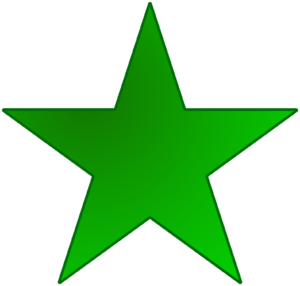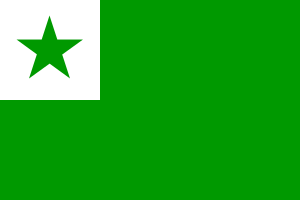Esperanto symbols facts for kids
Esperanto is the most widely used constructed language. This means someone created it on purpose, unlike natural languages that evolve over time. Like many languages and cultures, Esperanto has its own special symbols. These symbols help people recognize Esperanto and its community around the world.
Contents
What is the Green Star of Esperanto?
The main symbol of Esperanto is a green star with five points. Each point stands for one of the five traditional continents: Europe, America, Asia, Oceania, and Africa. The color green represents hope. Sometimes, when the star is used alone, it has the letter "E" added to it. In Esperanto, this star is called verda stelo, which means "green star."
What Does the Esperanto Flag Look Like?
The Esperanto flag has a bright green background. In the top left corner, there is a white square. Inside this white square, you will find the green five-pointed star. People who speak Esperanto use this flag to represent their language and culture. A Swedish esperantist named G. Jonson first suggested using the green color and the green star. The final design of the flag was created in 1893 by C. Rjabinis and P. Deullin. The green color on the flag means hope, and the white color stands for peace. In Esperanto, the flag is called Esperanto-flago.
What is the Jubilee Symbol?
In 1987, Esperanto celebrated its 100th anniversary. For this special occasion, the World Esperanto Association created a unique logo called the Jubilee symbol. This symbol looks like two "E" letters that are curved and facing away from each other. Together, they form a shape that looks like the Earth. In Esperanto, this symbol is known as Jubilea simbolo.
What is the Esperanto Anthem?
The official anthem of Esperanto is a poem called La Espero, which means "The Hope." L. L. Zamenhof, who created Esperanto, wrote the words for this poem. The music for the anthem was composed by Félicien Menu de Ménil.
Images for kids
-
Esperanto flags prominently displaying the Verda Stelo in Rotterdam
See also
 In Spanish: Símbolos del esperanto para niños
In Spanish: Símbolos del esperanto para niños





